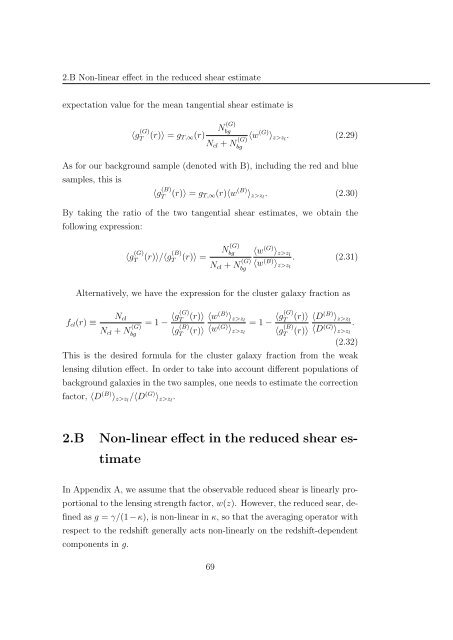Mass and Light distributions in Clusters of Galaxies - Henry A ...
Mass and Light distributions in Clusters of Galaxies - Henry A ...
Mass and Light distributions in Clusters of Galaxies - Henry A ...
You also want an ePaper? Increase the reach of your titles
YUMPU automatically turns print PDFs into web optimized ePapers that Google loves.
2.B Non-l<strong>in</strong>ear effect <strong>in</strong> the reduced shear estimate<br />
expectation value for the mean tangential shear estimate is<br />
〈g (G)<br />
T<br />
(r)〉 = g T,∞(r)<br />
N (G)<br />
bg<br />
N cl + N (G)<br />
bg<br />
〈w (G) 〉 z>zl . (2.29)<br />
As for our background sample (denoted with B), <strong>in</strong>clud<strong>in</strong>g the red <strong>and</strong> blue<br />
samples, this is<br />
〈g (B)<br />
T (r)〉 = g T,∞(r)〈w (B) 〉 z>zl . (2.30)<br />
By tak<strong>in</strong>g the ratio <strong>of</strong> the two tangential shear estimates, we obta<strong>in</strong> the<br />
follow<strong>in</strong>g expression:<br />
〈g (G)<br />
T<br />
(r)〉/〈g(B)<br />
T (r)〉 = N (G)<br />
bg<br />
N cl + N (G)<br />
bg<br />
〈w (G) 〉 z>zl<br />
〈w (B) 〉 z>zl<br />
. (2.31)<br />
Alternatively, we have the expression for the cluster galaxy fraction as<br />
f cl (r) ≡<br />
N cl<br />
N cl + N (G)<br />
bg<br />
= 1 − 〈g(G) T<br />
(r)〉<br />
〈g (B)<br />
T<br />
〈w (B) 〉 z>zl<br />
(r)〉 = 1 − 〈g(G) T<br />
(r)〉 〈D (B) 〉 z>zl<br />
〈w (G) 〉 z>zl 〈g (B) (r)〉 .<br />
〈D (G) 〉 z>zl<br />
T<br />
(2.32)<br />
This is the desired formula for the cluster galaxy fraction from the weak<br />
lens<strong>in</strong>g dilution effect. In order to take <strong>in</strong>to account different populations <strong>of</strong><br />
background galaxies <strong>in</strong> the two samples, one needs to estimate the correction<br />
factor, 〈D (B) 〉 z>zl /〈D (G) 〉 z>zl .<br />
2.B Non-l<strong>in</strong>ear effect <strong>in</strong> the reduced shear estimate<br />
In Appendix A, we assume that the observable reduced shear is l<strong>in</strong>early proportional<br />
to the lens<strong>in</strong>g strength factor, w(z). However, the reduced sear, def<strong>in</strong>ed<br />
as g = γ/(1−κ), is non-l<strong>in</strong>ear <strong>in</strong> κ, so that the averag<strong>in</strong>g operator with<br />
respect to the redshift generally acts non-l<strong>in</strong>early on the redshift-dependent<br />
components <strong>in</strong> g.<br />
69
















